Szigetköz region-revitalization of the ecological system
Organization: SZE (Hungary)
The Szigetköz water replenishment system has been set up and is operated in collaboration with stakeholders to dynamically control discharges and restore natural water levels on a 40 km long stretch of active and historical floodplain river branch system along the Danube, thereby creating diverse habitats while promoting ecological connectivity through fish passages.
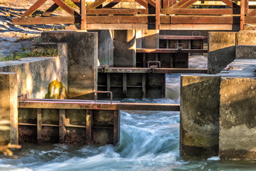

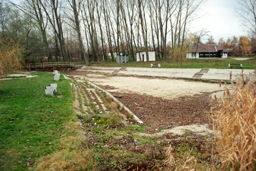
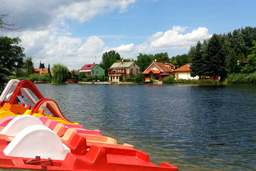
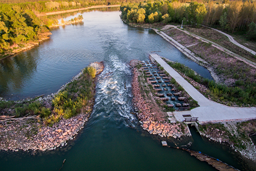
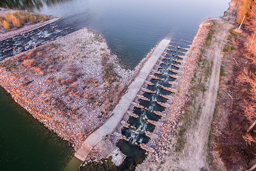
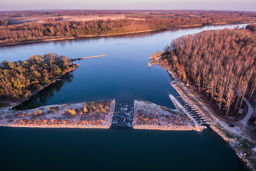
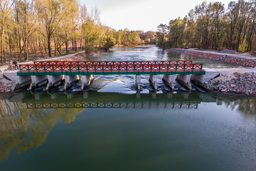
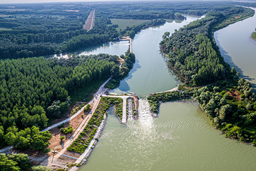
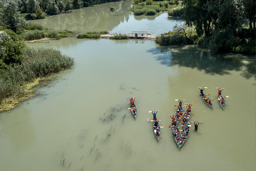
General Overview
The Danube River, after exiting the swift channels of the Alps and the Carpathians near Bratislava, Slovakia, experiences a significant decrease in gradient and velocity. This leads to sediment deposition, creating numerous islands in a complex system known as an inland delta. The southernmost branch of the Danube is the Mosoni-Danube, and the region between this branch and the main Danube is called Szigetköz, Hungary's largest island. Another large island, Csallóköz, exists on the Slovakian side.
In the 19th century, Hungarian river regulators implemented large-scale river regulation to create the main riverbed (Old Danube) amidst the tangled system of branches, improving navigation conditions. Flood protection dikes were subsequently constructed in the early 1900s, dividing the historic floodplain into active and historic areas.
The active floodplain is fragmented by several river branches, with islands covered mainly by floodplain forests. The historic floodplain is a mosaic landscape with agricultural land (55%), meadows, pastures (10%), thin strips of forest, canals, oxbow lakes, swamps, reeds, water bodies, wetlands (10%), and over 20 settlements (8%).
Since 1987, most areas of the active floodplain and some historical floodplain parts have been protected as the Szigetköz National Landscape Protection Area, contributing to the NATURA2000 network.
Implemented measures
Define the main objectives
After 1992, local water management interventions aimed to redesign and complete the water replenishment system outlined in the Gabčíkovo-Nagymaros Project. The primary goals were to mitigate the adverse effects of the Danube diversion and achieve a "good ecological status". Stakeholders, including environmentalists, played a crucial role in negotiating restoration goals, addressing conflicting demands, and reconciling interests.
Stakeholders prioritized maintaining flood protection and accepting the existing dike modifications. The emphasis shifted to designing water replenishment systems to enhance the river branch system's ecological condition and restore unique aquatic habitats. The reference period for ecological potential is the 1950s, chosen for its suitability in sustaining floodplain tributaries and ensuring continuous water supply to the Mosoni-Danube, aligned with natural flow dynamics.
Planning the water replenishment systems
The active floodplain replenishment system was designed to dynamically follow the natural fluctuations of the Danube discharge. Creating good water quality conditions was equally essential for ecological reasons. Analysis of hydrobiological data indicated that increased flow reduces eutrophication and riverbed clogging.
Construction and design of the water replenishment systems
The diversion of the Danube led to a significant drop in the water level of the Old Danube, impacting surface and groundwater levels in the active floodplain. To address this, hydraulic controls were implemented on both the Hungarian and Slovak sides, separating the main riverbed from the floodplain branch system. The comprehensive rehabilitation of Szigetköz involved stakeholder participation, official permits, and collaboration with Slovakia.
The Upper Szigetköz floodplain replenishment systems were constructed in 1995, relying on gravitational forces without pumping. In 2014-2015, the system expanded to the Lower Szigetköz, including ecological restoration of the Mosoni-Danube. Fish passes were incorporated for migration. The Mosoni-Danube outlet structure, completed between 2019 and 2022, aimed to counteract past river regulation effects.
Key hydraulic structures are constructed in Slovakia and Hungary, emphasizing water bodies and connectivity. Upstream controls, particularly at Rajka, play a crucial role. Discharge agreements determine water allocation between the Old Danube and floodplain systems, regulated by the Dunakiliti barrage and submerged weir.
The Mosoni-Danube receives a constant flow from Cunovo, divided among various water systems. The active floodplain's water, introduced in the Dunakiliti area, traverses multiple branches, regulated by crest weirs and other structures. Seepage loss to the Old Danube occurs, with additional recharge points to the historic floodplain. Four locations enable controlled discharge from the active to the historic floodplain. The historic floodplain system, comprising canals and sluice gates, operates with stakeholder consensus. Fish passes facilitate aquatic movement. The water replenishment systems mimic natural conditions, utilizing undisturbed Danube flow data. Mosoni-Danube follows a seasonal pattern, while historical floodplain targets align with the same trend. The system requires minimal maintenance, monitoring morphological changes but intervening only when necessary for water transport.
Establishment of the Szigetköz Operating Committee
Since 1993, stakeholders identified flood control as the top priority, given its critical role in ensuring the safety of settlements and the region. With flood protection as the primary focus, the existing system was justified. Following the prioritization of flood control, the goal shifted to achieving the remaining priorities, including maintaining an adequate drinking water supply, nature conservation, fishing, forestry, and tourism. Achieving these goals required balancing good ecological potential with the heavily modified morphological character of water bodies.
The Operating Committee, established in 2001, comprises representatives from water management, disaster prevention, nature conservation, forestry, agriculture, local government, fishing, and tourism organizations.
A notable achievement of the Operating Committee was the implementation of artificial flooding in the Szigetköz. This annual process, initiated in the spring if a natural flood occurs, imitates natural processes at the beginning of the vegetation period. Artificial flooding parameters were determined based on a 100% probability of a flood event under natural conditions, with specific discharge thresholds. This practice, occurring between April 1st and May 31st with a required water temperature above 10°C, facilitates natural processes such as groundwater recharge and fish spawning. If a larger natural flood (> 5000 m³/s) occurs during this period, artificial flooding is not necessary.
Impact of the measures on the environment
The implementation of water replenishment systems following the diversion of the Danube has brought about significant positive changes in the affected region. Surface and groundwater levels are higher compared to pre-diversion conditions, with surface water levels in the active floodplain meeting levels from the 1950s. The restoration of diverse aquatic habitats has been successful, as evidenced by surface and groundwater levels in the Dunakiliti region.
Water quality has undergone gradual improvements since the initiation of water replenishment. Before diversion, active and historic floodplain branches received water primarily through subsurface seepage, resulting in low total suspended solids (TSS) and nutrient levels but high residence time. Post-diversion, flowing water from the Dunakiliti Barrage has been introduced, addressing these water quality aspects.
A joint Hungarian-Slovak monitoring system was established in 1995, with results summarized in annual reports. Following the adoption of the Water Framework Directive (WFD), experts focus on differentiating between ecological parameters for good ecological status and potential. Fish migration studies have played a pivotal role in monitoring, and influencing the number of fish species in the active floodplain.
Forest growth in the Szigetköz floodplain has been monitored since 1986, with the diversion of the Danube in 1992 leaving a lasting impact. Artificial floods and major flood events have influenced forest growth positively, emphasizing the interplay between water dynamics and ecosystem health.
In agriculture, particularly in central Szigetköz, permanent lowering of groundwater levels due to the Danube diversion initially led to a decline in crop yields. However, water replenishment efforts have helped restore yields close to previous levels.
The restoration of active and historic floodplain branches has also fostered ecotourism in the region. The late 1990s and early 2000s witnessed an increase in camping sites and canoe rentals, with further development occurring after the spatial extension of replenishment systems in 2014-2015.
Summary and recommendations
Meeting human water needs often requires significant interventions in natural water systems, and in many places worldwide, this intervention is ongoing. Over time, changes in water demand may prompt alterations in these man-made systems, with some previous interventions potentially becoming environmentally harmful. In such cases, restoration efforts may be necessary to improve the ecological status of water bodies.
The "inland delta" of Szigetköz is a unique floodplain ecosystem, hosting 75% of the Hungarian fish fauna, 57% of the bird fauna, and 48% of the mollusk fauna. Historical changes, starting in the 19th century, were driven by river regulation for navigation and flood protection for agriculture. Hydropower stations in the Upper Danube catchment in the mid-20th century and the diversion of the Danube to the Gabčíkovo power plant in 1992 further modified the landscape, necessitating the restoration of the Szigetköz floodplain system.
The planning, construction, and operation of the Szigetköz Water Replenishment Systems offer insights into restoring heavily modified water bodies in a river floodplain. The system, covering a 40 km stretch of the Danube's active and historic floodplain, is operated collaboratively with stakeholders to dynamically control discharges and restore natural water levels. The restoration has resulted in diverse habitats, enhanced ecological connectivity through fish passages, and improvements in flood protection and water use opportunities.
Technical solutions, including fish passes, emphasize the ecological connectivity between separated water bodies. The Szigetköz water replenishment system showcases the successful restoration of water levels and the creation of eco-corridors, contributing to increased flood protection capacity and new water use opportunities.
Stakeholder involvement has been integral from the planning stage to define objectives and establish priorities for achieving good ecological potential. That led to the formation of the Operating Committee, a legal body regulating the operational water rights permit for the replenishment systems. The committee plays a key role in decision-making, supervision, and maintaining trust between stakeholders. Open planning processes and ongoing monitoring ensure the effectiveness of restoration efforts and allow for adjustments based on observed outcomes.
